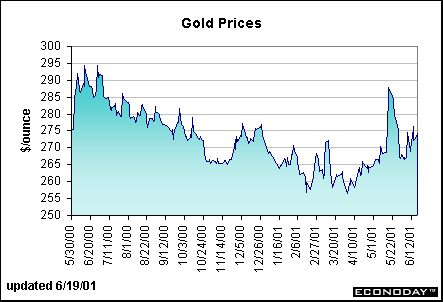Gold prices hold in tight range over past year
Comments made by past and current Fed officials suggest that gold prices remain a key indicator on the Fed's radar screen. The belief that gold is a hedge against inflation is widespread. Gold is also the investment of choice in times of war or market turmoil. Gold prices surged in the month just before the US stock market crash of 1987. To a much smaller degree, gold prices also picked up steam in the six months before the Nasdaq composite index peaked in March 2000.
Gold also has industrial uses so that increased demand for gold could come from strengthening economies. Conversely, gold prices can collapse when economic demand is weakening. Prices fell sharply in 1997 when the Asian crisis became full blown. The plunge in gold demand from Asia played a major role in depressing gold prices during 1998 and 1999.
The chart below depicts the price of gold over the past 15 years. Since gold is considered an inflation hedge, we compare the nominal price to the year-over-year percent change in the personal consumption expenditure deflator. Gold prices have been on a general decline even as prices continued to rise. A low rate of inflation or not, the value of real gold prices has declined.

The chart below depicts daily gold prices over the past year. Prices generally fell over the course of the year until May. The weaker prices came at the same time that consumer prices were showing signs of acceleration. Yet gold bugs (those who claim that the price of gold reflects the truth about the economy and inflation, such as former Fed Governor and current Bear Stearns Chief Economist Wayne Angell) could point to declining gold prices as proof that inflation was not a problem in the U.S. economy. Declining gold prices could also indicate weaker demand for gold in general as well as for industrial use. All this together would suggest softer economic activity. Indeed, history shows that gold prices fall during recessions. If recent price gains are sustained or if gold moves up further, it could mean that economic conditions are improving and economic growth will accelerate in the second half of the year. An important caveat not to be missed: gold is an international commodity. Prices reflect global demand, not just U.S. demand. Thus, one shouldn't make quick conclusions from small data movements.

Evelina M. Tainer, Chief Economist, Econoday
|